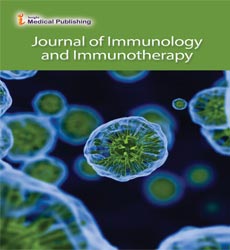Anti-spike Antibody Detection for a Better Understanding of SARS-CoV-2 Pathogenesis
Ethan Fisher*
Editorial office, Journal of Immunology and Immunotherapy, United Kingdom
- *Corresponding Author:
- Ethan Fisher Editorial office, Journal of Immunology and Immunotherapy, United Kingdom E-mail: jmso@emedicinejournals.org
Received Date: April 05, 2021; Accepted Date: April 08, 2021; Published Date: April 15, 2021
Citation: Fisher E (2021) Anti-spike Antibody Detection for a Better Understanding of SARS-CoV-2 Pathogenesis. J Immuno Immunother. Vol.5 No.2:07.
Editorial Note
The scientific community has made tremendous progress in understanding SARS-CoV-2 biology. These include the creation of numerous successful vaccinations that are already beginning to alleviate the consequences of illnesses throughout the world, as well as the identification and testing of treatment options for individuals unlucky enough to be hospitalized after being sick. Parallel to these advancements has been progress in our ability to identify both current viral infections and possibly protective immune responses developed after a person has been infected or immunized. The PCR test is the gold standard for identifying current illnesses. However, because PCR needs expensive specialized equipment, it is often conducted in specialized laboratories, with a turnaround time of about 24 hours. As a result, there is also a demand for more fast testing that may be conducted at home at a lower cost. In the United Kingdom, lateral flow devices intended to detect viral antigen expression are used to meet the demand for fast detection of viral antigens.
While PCRs and antigen detection tests are useful for detecting active infections, they do not identify whether a person has previously been exposed to the virus or any of the features of the immune response that arises. These statistics are critical for determining, for instance, the amount of protection against re-infection. This information on past infections and immune responses may be obtained in a variety of methods, including the assessment of virus-specific T cells or the measurement of SARS-CoV-2-specific antibodies produced by people following infection or vaccination. Antibody tests are extremely specific and may be tailored to detect reactions to vaccination or nonvaccine antigens. They may also be used to determine the immunoglobulin isotype of the identified antibody, which provides more information about the nature of the evoked immunological response. However, developing reliable assays is challenging and is influenced by a variety of factors, including an individual's level of infection, the location from which the sample is obtained, and the specific characteristics of the test employed.
As the epidemic proceeded, analyses of SARS-CoV-2-specific antibodies were produced and improved. Higher levels of spikespecific IgA and IgG have been demonstrated to correspond with greater clinical illness severity. More extensive investigations, known as the ‘systems serology' method, have identified differences in antibody responses between adults and children, which may drive more sophisticated creation of customized vaccinations in the future. In addition to antibodies specific for SARS-CoV-2 antigens, assessing auto-antibodies produced after infection is of interest. Tissue-specific autoantibodies can be found during severe infections and may have a role in worsening viral-induced disease.
To be helpful, studies of SARS-CoV-2-specific antibodies must utilize assays with high sensitivity and specificity to identify the antibodies in accessible biological materials. While antibodies are very simple to detect in patients with severe illness, antibody testing in people who are asymptomatic or have moderate symptoms are less accurate. We emphasize a work by a group that methodically built a high-sensitivity ELISA and utilized it to analyze the existence of anti-SARS-CoV-2 antibodies of IgA, IgG, and IgM isotypes in blood and saliva samples from PCR-confirmed non-hospitalized patients. The authors hypothesized that the difficulty in detecting antibody positivity in individuals with milder infections was due to two factors: first, the available assays are relatively insensitive, and second, the mucosal and systemic immune responses are compartmentalized, so antibodies circulating in serum may not readily be detected in saliva samples, which are more readily available. They were able to identify immune response in patients with low levels of infection after developing a highly improved ELISA employing trimeric spike glycoprotein. The most sensitive technique for identifying infections requires the combination of IgG, IgA, and IgM values. While the scientists were able to identify anti-viral antibodies in saliva, saliva-positive patients were less common than serum-positive persons and had greater levels of anti-viral antibodies in their serum. This study sheds light on the processes that regulate anti-viral antibody production in people with low levels of infection. As a result, it is a significant step toward creating the tools needed to understand the pathogenesis of SARS-CoV-2 infections and make wise decisions about how to effectively prevent infections and treat illness.
Open Access Journals
- Aquaculture & Veterinary Science
- Chemistry & Chemical Sciences
- Clinical Sciences
- Engineering
- General Science
- Genetics & Molecular Biology
- Health Care & Nursing
- Immunology & Microbiology
- Materials Science
- Mathematics & Physics
- Medical Sciences
- Neurology & Psychiatry
- Oncology & Cancer Science
- Pharmaceutical Sciences
